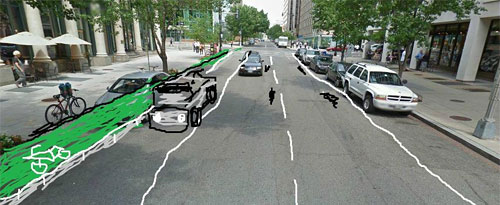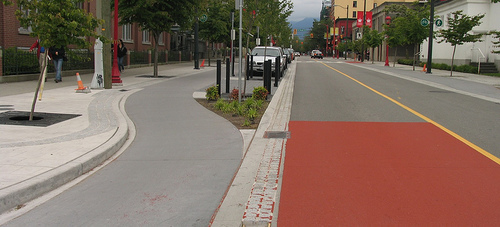Why DDOT chose no cycletrack for one block of M Street
If a church needs 3 of 4 lanes on a street for parking on Sundays, what’s better: shrink down a planned cycletrack to a basic painted bike lane, or allow parking in the cycletrack some of the time?
The long-awaited and much-delayed east-west protected bike lane, or “cycletrack,” will finally go in on M Street, NW in October, but without protection for cyclists on one block. Many residents have been quite angry at the sudden change.
I spoke to Sam Zimbabwe, the District Department of Transportation (DDOT) Associate Director for Policy, Planning, and Sustainability (which includes the bicycle program). He provided some more details on why he and his group made the decision they did.
There isn’t room to preserve all of the Sunday on-street parking on the block and add a cycletrack. Therefore, one of four things would have to happen:
- The block loses a significant amount of parking and flexibility, which particularly affects the church.
- People can park in the cycletrack on Sundays and during midday funerals.
- The cycletrack becomes just a classic painted bike lane.
- DDOT moves the tree boxes and completely rebuilds the north side sidewalks to create a sidewalk-level bike lane at much larger cost.
Zimbabwe and his team chose #3. If #1 were indeed politically infeasible, the question remains whether they were right to choose #3 over #2, or not.
The street today
M Street, NW between 15th and 16th has 90 feet from building to building, with 40 feet between curbs. Today, the road striping divides it into four 10-foot lanes. At rush hour, all four are ostensibly regular travel lanes, while parking is allowed at other times.
Metropolitan AME rents spaces in nearby garages on Sundays, but still uses a lot of on-street space for parking. The north side allows parallel parking, and the south side becomes diagonal parking on Sundays until 2 pm.

Current Sunday cross-section. (StreetMix doesn’t have a module for diagonal parking, so this shows perpendicular parking. The actual parking is back-in head-out diagonal parking.)
On weekdays, the church sometimes has funerals where people double park in front of the church, and events where large tour buses full of people arrive. Buses need to let off on the north side of the street. If this doesn’t happen against the curb, it would block a travel lane.
Can a cycletrack fit?
A cycletrack is at least 8 feet wide, according to Zimbabwe — 5 feet for the bike lane and a 3-foot buffer. On other blocks of M Street that have a similar width, DDOT will remove the parking on the south side (right side of these diagrams) and put full-time parking on the north (left) side, adjacent to the cycletrack. (At the corners, there will instead be mixing zones.)
If this block used the same design, then the church would not be able to have diagonal parking on Sundays, or much on-street parking at all for weekday funerals.
People could park in the cycletrack
How can the parking remain? In May, bicycle planners showed some concept designs, like one that had perpendicular parking in the cycletrack on Sundays. Or, DDOT could put the parking on the south side of the street, which has the advantage of being in front of the church rather than across the street, and allow parallel parking in the cycletrack.
Zimbabwe said he decided against this option because it could set a precedent of parking in cycletracks. Already, many people park in L Street’s cycletrack, especially delivery trucks. Other institutions may similarly ask to use cycletracks for parking at certain days and times, maybe even during special weekday events.
Philadelphia lets people park in bike lanes on Sundays, also to accommodate churches. But as that link explains, that practice has then spread to Saturdays for weddings and other times.
Or, give the cycletrack a gap
The bicycle planners have chosen to give this one block a painted bike lane instead of a cycletrack. That’s certainly a significant step down from the project’s promise to construct a continuous cycletrack from Thomas Circle to Pennsylvania Avenue.
Zimbabwe pointed out that this is one (fairly short) block on a cycletrack that will be 1.4 miles long. Right now, there is no bike lane at all, and even with this change, the road will have a bicycle facility and fewer travel lanes for the project’s whole length. He believes this is still a big step forward with just a small compromise. However, just as he worried about the precedent of parking in the cycletrack, advocates worry that excusing one block from the cycletrack also sets a precedent. Shane Farthing of WABA told Martin Di Caro, “I’m concerned that if we start allowing individual private, adjacent landowners to essentially opt out of public transportation projects, we are starting to allow private convenience to trump public safety.” Another former DDOT official agreed with this concern. The agency will be planning other cycletracks, bike lanes, bus lanes, streetcars, and other transportation projects across the city. Some of those will pass by churches and other community institutions. This experience could well encourage other such organizations to try to reduce or eliminate any changes to their own blocks. What about a sidewalk-level cycletrack? Darren Buck suggested raising the cycletrack to sidewalk height and placing it between the parked cars and the sidewalk: Many other cities around the world do this. Here is one in Vancouver: A painted bike lane is usually 5 feet wide. That puts cyclists in the door zone for cars, which isn’t so good. Just moving a 5-foot bike lane to the other side of parked cars still leaves it in the door zone, plus if someone opens a door, the cyclist can’t even ride away from the cars since the curb is there. That’s why DDOT adds a 3-foot buffer between parking and its cycletracks. But if the bike lane can be at sidewalk height, people might still be riding in the door zone, but that’s no worse than on the painted bike lane. Here, if a door is in the way, the cyclist can ride away from traffic, toward the pedestrians, instead. However, Zimbabwe said, this would be much more expensive, since DDOT would have to reconstruct the sidewalks and curbs along the north side of M. The curb cuts to garages would need changes, too, to stay at sidewalk height farther into the roadway before ramping down. Plus, there would still be other obstacles on the sidewalk side of the bike lane, especially the tree boxes, but also parking meters and signs. That means cyclists wouldn’t always have room to go around open car doors and other obstacles. An even better approach would be to move the tree boxes and parking meters toward the current roadway, and build the bike lane on the sidewalk side of the trees and meters and other things. That means replacing the trees, but there aren’t any really large trees on this block. The big obstacle is cost. This solution would cost about $1 million, compared to a cost of $210,000 for the entire bike lane project, Zimbabwe said. And there’s certainly no way to build that this year. What’s the right call? Certainly DDOT could also have pushed to remove parking instead. Zimbabwe explained that the church was initially entirely opposed to any sort of bike lane, and by engaging with church leaders and members over the last few months, that position has softened. Plus, any bike lane is today just an abstract notion; when a real bike lane is in the ground, Zimbabwe thinks all parties may think a little differently about the issue. Meanwhile, DDOT plans to study whether the missing block deters cyclists who might otherwise use M Street, and look at whether more people ride on the sidewalk on this block than elsewhere. Zimbabwe and his team made clear to the church that if this design doesn’t work, they may make changes, even if that means less parking. If we assume that less parking were’t an option for now, Zimbabwe and his team picked the bad precedent of having only a painted bike lane for one block in the middle of a cycletrack, instead of the bad precedent of allowing Sunday parking in the cycletrack. Maybe that’s the right call, or maybe not. Many commenters on our earlier post disagreed, like Darren Buck. Regardless of DDOT’s decision, this seems like a bigger policy question for future cycletracks as well. It would be good for the bicycle planners to engage with cyclists to discuss this question. What do you think? Make a choice on the poll below, then give your detailed thoughts in the comments.









